TESTING TOOLS
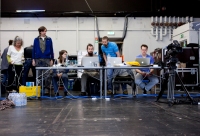
© Jessica Schäfer
The Dance Congress offers the opportunity to test different tools. These tools were for the most part developed based on selected productions and concrete tasks and worked out by interdisciplinary teams of choreographers, dancers and media artists, but also psychologists, physicians and neuroscientists. Available are online tools for conveying compositional principles, for example, the interactive score of Deborah Hay’s solo ‘No Time to Fly’ developed in the frame of William Forsythe’s research project ‘Motion Bank’. Dance-medical tools serve to treat the body of the dancer in a healthier way, while the ‘TanzSprints’ allow learning various training techniques, and a coaching conveys exercises in self-marketing suitable for daily use.
Fri, 7 June 13:00
-
13:00 - 13:30 tanzhaus, Studio 1, 2 & 6
TanzSprint 2013
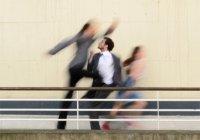 © Miranda Glikson
© Miranda GliksonEach year, students of the Frankfurt Master’s study programme Contemporary Dance Pedagogy (MAztp) organise the one-week workshop festival ‘TanzSprint’ for amateur and professional dancers. For the Dance Congress they have developed various physical-dancerly training offers from current working material on dance techniques and digital tools, which will take place daily, parallel in five studios. In teachings à 30 minutes, a broad range of new training approaches will be tested. Contemporary exchange and mediation formats provide a wide variety of experiences with the art form.
Zoé Alibert, Anja Bornšek, Patricia Gimeno, Miranda Glikson, Jason Jacobs, Gregory Livingston, Ola Scibor (D) students of MAztp
Concept:
Ingo Diehl (D) direction MAztp, Hochschule für Musik und Darstellende Kunst Frankfurt/M.Space Walk tanzhaus, Studio 1
This workshop will examine spatial environment as an extension of our selves.
Referencing spatial atmospheres and architectural principles we will physically experience how spaces organise our body and define movement behaviour. In a focused 30-minute exploration movement tasking and awareness approaches deal with the structures of our surrounds. Engaging with the notion of borders, of inside/outside and public/private realm, we explore the temporal qualities of spatial conditions.Miranda Glikson (AUS/D) dancer
The TK Shuffle tanzhaus, Studio 2
“[...] it’s about walking, moving the arms, turning and jumping.” (DVD 1, A Choreographer’s Score, 2012) The cornerstone from which this physical training will be constructed, references „A Choreographer’s Score“ by Anne Teresa de Keersmaeker. We will explore simple elements, maneuvering the “minimal of material in a maximum way“. Unfolding into accumulation, the space confronts our relationships to others within “simple geometrical underlying patterns“.
Gregory Livingston (USA/D) dancer, choreographer
Moving Oppositions tanzhaus, Studio 6
This physical exploration is a response to Jason’s experience working with choreographer Hofesh Shechter and inspired by the publication “A Choreographer’s Score” by Anne Teresa De Keersmaeker and Bojana Cvejić. Our movement is stimulated by imagery and organised by choreographic structure. Physicality is proposed through a focus on movement quality, which incorporates opposing concepts of soft and sharp, continuous and broken, heavy and light. Individual corporeal engagement connects to a collective movement experience questioning assumptions and possibilities of choreographic structure.
Jason Jacobs (D) choreographer, performer, dance teacher
-
13:30 - 14:00 tanzhaus, Studio 3 & 4
TanzSprint 2013
 © Miranda Glikson
© Miranda GliksonEach year, students of the Frankfurt Master’s study programme Contemporary Dance Pedagogy (MAztp) organise the one-week workshop festival ‘TanzSprint’ for amateur and professional dancers. For the Dance Congress they have developed various physical-dancerly training offers from current working material on dance techniques and digital tools, which will take place daily, parallel in five studios. In teachings à 30 minutes, a broad range of new training approaches will be tested. Contemporary exchange and mediation formats provide a wide variety of experiences with the art form.
Zoé Alibert, Anja Bornšek, Patricia Gimeno, Miranda Glikson, Jason Jacobs, Gregory Livingston, Ola Scibor (D) students of MAztp
Concept:
Ingo Diehl (D) direction MAztp, Hochschule für Musik und Darstellende Kunst Frankfurt/M.3, 2, 1 ... Action tanzhaus, Studio 3
In this physical exploration we utilise Newton’s Law of Action and Reaction as guidance to work with weight, resistance and absorption. Integrating the concept of gravity from “Material for the Spine” by Steve Paxton, we navigate back and forth between the centre of the body and its reactions to the periphery. Using different games and interactions participants play, move and dance!
“If you hit the ground rolling, all the landing energy can be transformed and redirected parallel to the ground, rather than harshly perpendicular to it.” (Material for the Spine. Contredanse. 2008)Patricia Gimeno (ES/D) dancer, performer, dance pedagogue
Collective Practice for the Spine tanzhaus, Studio 4
Drawing from Steve Paxton’s (Material for the Spine) and Alice Chauchat’s scoring proposal (Collective Sensations Practice), we will use our spine as a source of experiential information, allowing it to organise and establish individual moving environments. By verbally offering physically perceived information into the space, we build a score based structure. Growing and branching it collectively, enables us to tackle strategies of relations, decision-making and processes of contextualisation on an individual as well as a group level.
Anja Bornšek (D) somatic movement educator
Fri, 7 June 14:00
-
14:00 - 15:30 Capitol, Club Video
Motion Bank Score Release
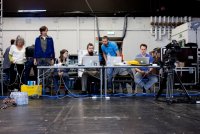 © Jessica Schäfer
© Jessica Schäfer‘Motion Bank’ is a research project of The Forsythe Company focusing on exploring the potential of computer-based tools and techniques to translate choreographic principles. Through modern computer technology, the choreographies of a select group of artists are turned into digital scores that will be published online. This direct access to the compositional principles of choreographic work is to be used by different fields including dance education and digital arts practices. At the Dance Congress, the interactive score created from three different adaptions of Deborah Hay’s solo ‘No Time to Fly’ will be presented for the first time. Deborah Hay, William Forsythe and the digital artists Florian Jenett and Amin Weber give insights into the development process. Jonathan Burrows and Matteo Fargion share reflections on their score project to be released in November 2013.
William Forsythe (D), Deborah Hay (USA), Jonathan Burrows (UK) choreographers
Florian Jenett (D), Amin Weber (D) digital artists
Matteo Fargion (I/UK) performer, composer
Moderation:
Scott deLahunta (D) project leader Motion Bank
Motion Bank is supported by Kulturstiftung des Bundes, Kulturfonds Frankfurt RheinMain, Hessisches Ministerium für Wissenschaft und Kunst, Altana Kulturstiftung
Fri, 7 June 16:00
-
16:00 - 18:00 tanzhaus, Foyer
Times in Motion
A Look at Facets of Dance Medicine
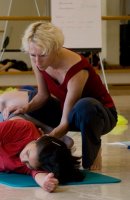 © Susanne Lencinas
© Susanne LencinasIn exercising their profession, dancers are exposed to extreme bodily strains comparable to those of top athletes. Dance medicine allows including the newest scientific insights in the dancer’s everyday professional life. The discussion and consultation offer presents a selection of current topics such as nutrition, fascia, dance and embodiment, aging and the prevention of injuries. At different thematic tables which can be changed every 30 minutes, physicians, scientists, nutritionists, and therapists answer questions and discuss with the Congress visitors.
In German and English
Concept:
Liane Simmel (D) tamed e.V.Nutrition in Dance
For a dancer’s health and efficiency, healthy nutrition and the optimal intake of liquid are just as important as regular training. The most important facts on the issue of ‘Nutrition in Dance’ will be conveyed, the results of a survey on the dietary habits of 243 dancers will be presented and questions answered.Eva-Maria Kraft (A) dance pedagogue, dancer, nutrition trainer
Dancing in a Healthier Way. How Can That Work?
How can one best cope with the physical, mental and aesthetic challenges of the dancer’s profession? Margot Rijven gives advice on a healthier lifestyle, gentle training and the prevention of injuries.Margot Rijven (NL) former coordinator of dance & health de Theaterschool, Amsterdam School of the Arts
Thinking Bodies/Dancing Brains – Dance and Embodiment
What impact did the paradigm change regarding the body-mind problem triggered by the neurosciences have on dance? Which neurophysiological insights are important for dancers and dance teachers?Anja Weber (D) dancer, psychologist, physician
Fascia.
Networks in the Dancing Body
Like cobwebs, a collagenous network of fibres, the so-called fascia, permeate the entire body. How do new insights into the fascia influence dance, what capabilities are attributed to the fascia system and how can they be trained in a targeted way?Liane Simmel (D) dance physician
Danièle-Claude Martin (D) physicist, movement researcher
Fri, 7 June 17:00
-
17:00 - 19:00 Capitol, Studio
Working with Deborah Hay’s Motion Bank Score
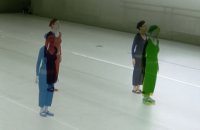 © Amin Weber & Florian Jenett
© Amin Weber & Florian JenettWhen developing an interactive digital score, a live performance is “translated” to a digital medium to explain the relationship between dance in real-time, video recordings and choreographic notes. In this workshop, Congress visitors can experiment with tools and methods created for developing the online digital score of Deborah Hay’s piece ‘No Time to Fly’ for ‘Motion Bank’. Hay’s dancer Jeanine Durning and digital artists Florian Jenett and Amin Weber will provide starting points for drawing inspiration from the digital score to generate new choreographic ideas and forms as well as re-connect with Hay’s specific ways of working.
Registration required
Jeanine Durning (USA) dancer
Florian Jenett (D), Amin Weber (D) digital artists Motion Bank
Supported by Motion Bank
Sat, 8 June 13:00
-
13:00 - 13:30 tanzhaus, Studio 1, 2 & 6
TanzSprint 2013
Z. Alibert, P. Gimeno, O. Scibor © Miranda Glikson
© Miranda GliksonEach year, students of the Frankfurt Master’s study programme Contemporary Dance Pedagogy (MAztp) organise the one-week workshop festival ‘TanzSprint’ for amateur and professional dancers. For the Dance Congress they have developed various physical-dancerly training offers from current working material on dance techniques and digital tools, which will take place daily, parallel in five studios. In teachings à 30 minutes, a broad range of new training approaches will be tested. Contemporary exchange and mediation formats provide a wide variety of experiences with the art form.
Zoé Alibert, Anja Bornšek, Patricia Gimeno, Miranda Glikson, Jason Jacobs, Gregory Livingston, Ola Scibor (D) students of MAztp
Concept:
Ingo Diehl (D) direction MAztp, Hochschule für Musik und Darstellende Kunst Frankfurt/M.3, 2, 1 ... Action tanzhaus, Studio 1
In this physical exploration we utilise Newton’s Law of Action and Reaction as guidance to work with weight, resistance and absorption. Integrating the concept of gravity from “Material for the Spine” by Steve Paxton, we navigate back and forth between the centre of the body and its reactions to the periphery. Using different games and interactions participants play, move and dance!
“If you hit the ground rolling, all the landing energy can be transformed and redirected parallel to the ground, rather than harshly perpendicular to it.” (Material for the Spine. Contredanse. 2008)Patricia Gimeno (ES/D) dancer, performer, dance pedagogue
Coordin8ed tanzhaus, Studio 2
Taking Steve Paxton’s Small Dance as a starting point, we will challenge our awareness and coordination by trying to localise centers within centers. Introducing the movement of the figure 8, we inspect elemental patterns such as walking and crawling, to then explore more complex patterns within spontaneously gener8ed dances. Within these perspectives, we move from inside out and from outside in – to perceive our bodies 3-dimensionally.
What sort of rhythms can we create in our bodies as we trace an infinite form? What kind of coordination, momentum and efficiency can we discover as we draw such a non-orientable shape? What spaces unfold in and outside of us?Zoé Alibert (D) performer, choreographer, teacher
What about Dancing? tanzhaus, Studio 6
“Let us begin with the idea that you know how to dance.” Referring to the questions Jonathan Burrows asks in ”A Choreographer’s Handbook”we set on a physical and explorative journey into the idea of dancing. “What is your relationship to the idea of dancing? What are the qualities that drew you towards dancing in the first place?” “What do you know that you have forgotten that you know?” “Forget all this.” “Just dancing is enough.”
Ola Scibor (D) dancer, interpreter, contemporary dance teacher
-
13:15 - 13:45 tanzhaus, Studio 3 & 4
TanzSprint 2013
 © Miranda Glikson
© Miranda GliksonEach year, students of the Frankfurt Master’s study programme Contemporary Dance Pedagogy (MAztp) organise the one-week workshop festival ‘TanzSprint’ for amateur and professional dancers. For the Dance Congress they have developed various physical-dancerly training offers from current working material on dance techniques and digital tools, which will take place daily, parallel in five studios. In teachings à 30 minutes, a broad range of new training approaches will be tested. Contemporary exchange and mediation formats provide a wide variety of experiences with the art form.
Zoé Alibert, Anja Bornšek, Patricia Gimeno, Miranda Glikson, Jason Jacobs, Gregory Livingston, Ola Scibor (D) students of MAztp
Concept:
Ingo Diehl (D) direction MAztp, Hochschule für Musik und Darstellende Kunst Frankfurt/M.Moving Oppositions tanzhaus, Studio 3
This physical exploration is a response to Jason’s experience working with choreographer Hofesh Shechter and inspired by the publication “A Choreographer’s Score” by Anne Teresa De Keersmaeker and Bojana Cvejić. Our movement is stimulated by imagery and organised by choreographic structure. Physicality is proposed through a focus on movement quality, which incorporates opposing concepts of soft and sharp, continuous and broken, heavy and light. Individual corporeal engagement connects to a collective movement experience questioning assumptions and possibilities of choreographic structure.
Jason Jacobs (D) choreographer, performer, dance teacher
The TK Shuffle tanzhaus, Studio 4
“[...] it’s about walking, moving the arms, turning and jumping.” (DVD 1, A Choreographer’s Score, 2012) The cornerstone from which this physical training will be constructed, references „A Choreographer’s Score“ by Anne Teresa de Keersmaeker. We will explore simple elements, maneuvering the “minimal of material in a maximum way“. Unfolding into accumulation, the space confronts our relationships to others within “simple geometrical underlying patterns“.
Gregory Livingston (USA/D) dancer, choreographer
Sat, 8 June 14:00
-
14:00 - 15:30 tanzhaus, Studio 6
Choreographic Resources Lab
In the past several years, numerous choreographers have sought to make their work generally accessible by using digital media. Their projects have resulted in tools that can be used in education and professional dance practice. This lab examines them in regard to common features and differences. Based on ‘A Choreographer’s Score’ by Anne Teresa De Keersmaeker and Bojana Cvejić, Steve Paxton’s DVD ‘Material for Spine’, the website on William Forsythe’s ‘Synchronous Objects for One Flat Thing, reproduced’, and the interactive score of Deborah Hay’s ‘No Time To Fly’, participants can explore the connection between technology and creativity.
Ingo Diehl (D) Hochschule für Musik und Darstellende Kunst Frankfurt/M.
Scott deLahunta (D) project leader Motion Bank
Zoé Alibert, Anja Bornšek, Patricia Gimeno, Miranda Glikson, Jason Jacobs, Gregory Livingston, Ola Scibor (D) students of MAztp -
14:00 - 16:00 tanzhaus, Studio 3
Things to Know About the Theme of Tension
Permanent tension induced by stress or traumas sooner or later leads to false postures, blockades, compensation mechanisms, and fatigue. As a cranio-sacral therapist at a specialty hospital for patients suffering from burn-out and depression, Claudia Pitt treats the results of protective and permanent, excessive, basic tension. This workshop seeks to help the participants perceive the extent of their individual tension in order to open up paths out of the tension brace using, among others, the ‘Gentle Movements’ method according to Danielle Pirera.
In German
Registration required
It is recommended to bring a blanket/mat and cushionClaudia Pitt (D) dancer, health coach, Cranio Sacral therapist
-
14:30 - 18:00 tanzhaus, Studio 4
How do I Present my Art?
By chance you meet the person who can open the doors to your desired project – at a party, a congress or in an elevator. Now you should have an elevator pitch up your sleeve, a short self-presentation that is surprising, makes one curious and communicates your skills. In this workshop, you will put the essence of your art in a nutshell: in memorable images, short clear sentences and a structure that is exciting.
Together with the other participants, you develop a text, present the result in front of the group and receive feedback on its effects on the listeners.In German
Registration requiredEdith Schütte (D) psychologist, coach
Sun, 9 June 13:00
-
13:00 - 13:30 tanzhaus, Studio 1, 3, 5 & 6
TanzSprint 2013
Z. Alibert, A. Bornšek, M. Glikson, O. Scibor © Miranda Glikson
© Miranda GliksonEach year, students of the Frankfurt Master’s study programme Contemporary Dance Pedagogy (MAztp) organise the one-week workshop festival ‘TanzSprint’ for amateur and professional dancers. For the Dance Congress they have developed various physical-dancerly training offers from current working material on dance techniques and digital tools, which will take place daily, parallel in five studios. In teachings à 30 minutes, a broad range of new training approaches will be tested. Contemporary exchange and mediation formats provide a wide variety of experiences with the art form.
Zoé Alibert, Anja Bornšek, Patricia Gimeno, Miranda Glikson, Jason Jacobs, Gregory Livingston, Ola Scibor (D) students of MAztp
Concept:
Ingo Diehl (D) direction MAztp, Hochschule für Musik und Darstellende Kunst Frankfurt/M.Coordin8ed /Studio 1
Taking Steve Paxton’s Small Dance as a starting point, we will challenge our awareness and coordination by trying to localise centers within centers. Introducing the movement of the figure 8, we inspect elemental patterns such as walking and crawling, to then explore more complex patterns within spontaneously gener8ed dances. Within these perspectives, we move from inside out and from outside in – to perceive our bodies 3-dimensionally.
What sort of rhythms can we create in our bodies as we trace an infinite form? What kind of coordination, momentum and efficiency can we discover as we draw such a non-orientable shape? What spaces unfold in and outside of us?Zoé Alibert (D) performer, choreographer, teacher
Space Walk /Studio 3
This workshop will examine spatial environment as an extension of our selves.
Referencing spatial atmospheres and architectural principles we will physically experience how spaces organise our body and define movement behaviour. In a focused 30-minute exploration movement tasking and awareness approaches deal with the structures of our surrounds. Engaging with the notion of borders, of inside/outside and public/private realm, we explore the temporal qualities of spatial conditions.Miranda Glikson (AUS/D) dancer
What about Dancing? /Studio 5
“Let us begin with the idea that you know how to dance.” Referring to the questions Jonathan Burrows asks in ”A Choreographer’s Handbook”we set on a physical and explorative journey into the idea of dancing. “What is your relationship to the idea of dancing? What are the qualities that drew you towards dancing in the first place?” “What do you know that you have forgotten that you know?” “Forget all this.” “Just dancing is enough.”
Ola Scibor (D) dancer, interpreter, contemporary dance teacher
Collective Practice for the Spine /Studio 6
Drawing from Steve Paxton’s (Material for the Spine) and Alice Chauchat’s scoring proposal (Collective Sensations Practice), we will use our spine as a source of experiential information, allowing it to organise and establish individual moving environments. By verbally offering physically perceived information into the space, we build a score based structure. Growing and branching it collectively, enables us to tackle strategies of relations, decision-making and processes of contextualisation on an individual as well as a group level.
Anja Bornšek (D) somatic movement educator